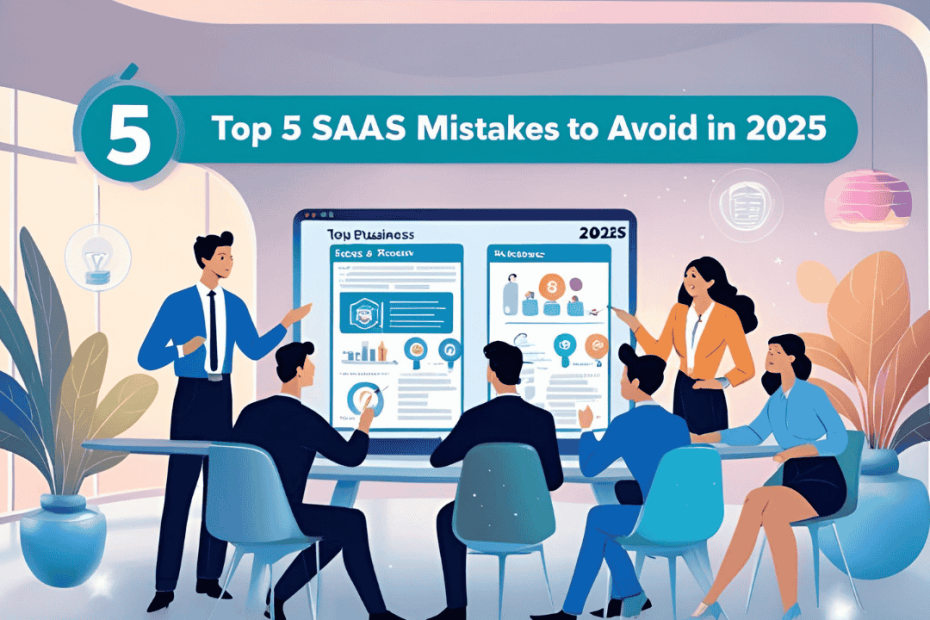SaaS (Software as a Service) tools have revolutionized how businesses operate. Whether it’s project management, communication, email marketing, or data analytics—SaaS applications streamline processes and improve productivity. However, while SaaS offers immense benefits, many businesses unknowingly make critical mistakes that limit their efficiency, increase costs, and pose data security risks. This comprehensive guide outlines the top 5 mistakes to avoid when using SaaS products in 2025, and how to make the most of your software investments.
Table of Contents
- Introduction to SaaS in 2025
- Mistake #1: Choosing the Wrong SaaS Product
- Mistake #2: Ignoring Data Security and Compliance
- Mistake #3: Underutilizing Features and Integrations
- Mistake #4: Lack of Team Training and Onboarding
- Mistake #5: Not Evaluating ROI and Performance Metrics
- Bonus Tips for Successful SaaS Implementation
- Final Thoughts
- Meta Description
- Target Keywords
- Tags
Introduction to SaaS in 2025
The SaaS industry in 2025 is growing at an unprecedented pace. With the rise of AI, remote work, and data-driven decision-making, more organizations are shifting to SaaS platforms. From startups to enterprises, SaaS solutions provide scalable, cost-effective, and innovative ways to manage workflows. But rapid adoption also increases the chances of missteps that can cost your business time, money, and opportunities. That’s why understanding what to avoid is just as important as knowing what to adopt.
Mistake #1: Choosing the Wrong SaaS Product
One of the biggest mistakes is selecting a SaaS tool based solely on popularity or price. A flashy UI or big brand name doesn’t guarantee the tool fits your business’s specific needs.
How to Avoid
- Define your goals and key use cases before searching.
- Involve your team in the decision-making process.
- Compare different tools using free trials or demos.
- Read independent reviews and SaaS comparison articles.
- Check compatibility with your existing tools.
Mistake #2: Ignoring Data Security and Compliance
With increasing regulations like GDPR, HIPAA, and CCPA, businesses can’t afford to overlook data privacy. A single breach or non-compliance issue can result in massive fines and reputational damage.
How to Avoid
- Choose SaaS vendors with strong encryption and secure data centers.
- Ask about their compliance certifications (SOC 2, ISO 27001, etc.).
- Implement role-based access controls (RBAC).
- Review their privacy policy and data handling practices.
Mistake #3: Underutilizing Features and Integrations
Most SaaS tools come loaded with features designed to improve productivity. However, many companies use just 20–30% of what the software can offer, leading to wasted potential.
How to Avoid
- Assign a team member to explore advanced features.
- Schedule monthly check-ins to review feature usage.
- Enable integrations with other business tools like CRMs, calendars, or ERPs.
- Attend webinars and user training sessions offered by the SaaS provider.
Mistake #4: Lack of Team Training and Onboarding
Deploying a SaaS tool without properly training your team leads to poor adoption and frustration. If users don’t understand the tool, they won’t use it effectively—or at all.
How to Avoid
- Provide onboarding sessions for all new users.
- Create documentation or short videos for internal use.
- Use built-in tutorials and guides offered by the SaaS provider.
- Encourage feedback and continuous learning.
Mistake #5: Not Evaluating ROI and Performance Metrics
Many businesses don’t track whether their SaaS tools are delivering expected outcomes. Without clear KPIs, it’s impossible to know if a tool is worth its cost.
How to Avoid
- Set measurable goals (e.g., reduce task time by 30%, improve email open rates by 20%).
- Use dashboards and analytics provided by the SaaS tool.
- Conduct quarterly audits to assess cost vs. performance.
- Replace underperforming tools with better alternatives.
Bonus Tips for Successful SaaS Implementation
- Choose scalable tools that grow with your business.
- Use API integrations for better workflow automation.
- Regularly update and review SaaS licenses and subscriptions.
- Keep an eye on user feedback and adjust your tool stack accordingly.
Final Thoughts
SaaS tools are powerful, but they’re not a magic bullet. Avoiding these common mistakes ensures you maximize ROI, enhance team productivity, and maintain security. In 2025 and beyond, a strategic approach to SaaS adoption can be a game-changer for any business.
